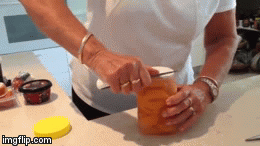“I’ll huff, and I’ll puff, and I’ll tear your packaging open.”
There is a well-known but paradoxically little recognised exercise routine being played out almost daily in kitchens across the planet.
Its name?
Let’s call it
“Keep Fit Kitchen”
Not a new activity this is a perennial form of exercise where the main thrust is placed in chest expanding routines.
In addition to straining and chest building there is also the art and skill of utensil usage.
For example the knife, the ultimate go-too tool for frustrated consumers in the quest to open the unopenable; be it a jar of peaches or a bag of peanuts.
And of course there’s the scissors, the ultimate tool for breaking through that impermeable plastic.
And while this exercise gets played out predominantly in kitchens, the exercise does not stay there, extending itself to laundries and bathrooms.
A key inclusion in this regular routine is what we refer to as the “peg” factor. This is where, after much effort has been applied to open a package, it then requires more tools to close and reseal.
What works and doesn’t work?
Watch Me Think’s recent global packaging research set out to simply understand what works and doesn’t work for consumers when it comes to FMCG packaging.
While the research didn’t unearth some new trend or wave to ride, it was powerful and insightful in its simplicity.
Three key things work for a consumer when it comes to consumer packaging:
- It opens easily
- Consumption without mess is a reality
- Resealability is the norm not the exception
Not rocket science.
Pretty simple.
And yet so many products fail to meet this criteria.
So why does the “Keep Fit Kitchen” exist?
Why does core packaging functionality fail?
Is it a case of:
- Too much focus on the brand design elements to create a desirable product?
- Operation limitation in the factory?
- Differing consumer needs from the one product?
- Consumers not willing to pay for packaging changes such as resealability?
- Failure to do the most basic of testing by putting the product into the hands of a consumer before major investment is made?
- The brand is so strong that consumers will “put up” with the inconvenience of poor pack functionality?
Resealability
Resealability was an overriding issue for our research when it came to packaging that didn’t work. And of course the contra side to this was packaging that did seal.
Of the categories consumers mostly pulled out to reference as a source of frustration were the breakfast cereals and salty snacks – smallgoods and bread featured as well.
If you have produced a product that is not (health consciously) not supposed to be consumed in one go, then it needs to be resealed to store and keep fresh.
(It’s surprising there haven’t been cross promotional campaigns with FMCG companies and IKEA given the number of IKEA pegs which consumers use.)
The Bane of Breakfasts
For the breakfast cereal category, universally consumers struggle with keeping their cereal fresh, mess free and neatly stored in their pantry.
The question needs to be asked why, when there is so much consumer angst over cereal boxes, is there little packaging innovation?
Cardboard boxes need an inner lining to protect the fragile ceral. Got it. Tick.
(Though let’s be honest: the logistics chain has the opportunity to improve on this. There for the taking. And an opportunity to possibly propel a brand into a market leading position?)
But in a mature and established category – like breakfast cereals – surely improved packaging changes are a path to increasing market share?
In our Australian section of the research, SunSol muesli is repeatedly referenced as a form of packaging utopia. If you haven’t seen this product then its description is simple… it looks good, feels good, communicates well, opens and seals. Easy.
Are consumers willing to pay for what they demand?
Will they pay extra for functionality such as ease of sealing a product?
For some consumers the answer is a definite yes, with the frustration driving them to switch brands.
In other cases there is an expectation that when you buy a generic low cost cereal the expectation of functionality is low. However shift the price up and up goes the expectation.
Resealing is becoming an expectation, not a feature
While knives and scissors still play a role in opening consumer products, packaging innovation has lowered the need to keep opening the cutlery drawer.
Resealing is therefore fast becoming an expectation not a premium feature which most consumers are happy to pay more for.
Two key starting points:
- Determine – through direct observational in-situ use – if will your product be consumed in one go therefore making the resealing capability redundant
- If your pack size is indeed such that it is used in portions: determine what people do now to reseal/re-use through direct observational in-situ use. Have you already got it spot on? Or are you kidding yourself with a tick box on a form back in the office (“Reseals? Yup. Done.”)
Put the product in the hands of a consumer and observe not only its desirability and appeal but how easy it is to open, reseal and store.
And it goes without saying, if you are offering resealability then just make sure it does in fact re-seal! 🙂
Like to know a bit more?
Here’s a summary of interesting highlights from our 2016 packaging study…



Comments
Comments are disabled for this post